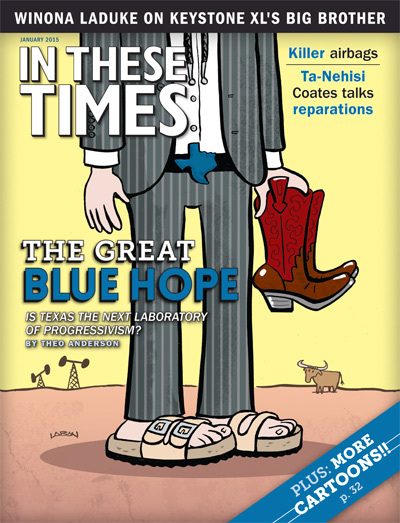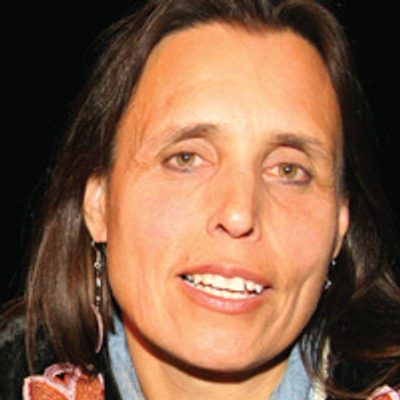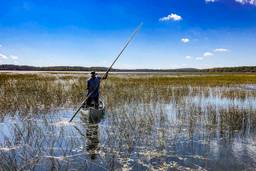
This is land that has been in my family for decades. It is prime Red River Valley agriculture land. It was handed down to me by my mother and father when they passed away, and I’m intending to hand it down to my children when I pass away. Of course, if thousands of barrels of oil burst through this thing, that is the end of the family legacy.
—James Botsford, whose land lies along the proposed route of Enbridge’s Sandpiper Pipeline Project
While the national press has focused on the controversy over TransCanada’s Keystone XL pipeline, the Canadian energy giant Enbridge is planning something even bigger. If the corporation gets its way, it could soon be transporting nearly 4 million barrels of oil every day — more than four times the amount piped by the proposed Keystone XL — across the ecologically sensitive Minnesota Northwoods.
“Northern Minnesota is becoming the superhighway for oil,” says Paul Blackburn, an attorney for Minnesota’s branch of the national climate justice group 350.org.
Enbridge’s 50,000 miles of pipelines span the continent, but the corporation is planning a massive expansion in the Great Lakes basin. This scheme could prove devastating to public and environmental health, as well as the rights of the Anishinaabeg people, who are entitled by federal treaties to use Minnesota’s natural resources to maintain their livelihoods.
The Enbridge Pipeline System, some portions of which date back to 1950, transports crude oil from production facilities in the Athabasca oil sands of Alberta, Canada, to refineries in the United States and Ontario, Canada. Approximately 2 million barrels of oil per day (bpd) are carried through a stretch of the pipeline network that extends from Gretna, Manitoba, where it crosses the border, to a major junction in Clearbrook, Minnesota. From there, a smaller number of pipelines continue on to the seaport of Superior, Wisconsin, where the oil is finally shipped to refineries throughout the Midwest and Eastern Canada.
Enbridge is currently expanding two of the pipelines to Superior in order to increase their carrying capacity. The company has also proposed construction of an entirely new line: the $2.5 billion, 600-mile-long Sandpiper Pipeline Project, which will carry light sweet crude oil — the most in-demand form of crude — from the Bakken shale in North Dakota to Lake Superior.
Let’s do some math. If both the expansions of Enbridge’s existing pipelines and the construction of the Sandpiper are completed, an additional volume of oil exceeding 1 million bpd will soon be headed to Superior, Wisconsin, home to the Calumet refinery.
Calumet has a capacity of just 45,000 bpd. Much of the crude oil will be piped on to larger refineries in Sarnia, Ontario. So, that means moving more oil into an aging pipeline infrastructure in the Great Lakes Basin, where many advocates believe that Enbridge’s pipelines desperately need updating. Not to mention the oil that could be shipped on tankers through the Great Lakes, beginning with Gichi Gummi, as we Anishinaabeg (also known as Ojibwe) call Lake Superior. Gichi Gummi is unique in depth and purity, and its water pretty much stays put. So one spill, and that’s not a good thing for the world’s largest freshwater lake.
In short, we are talking about a lot of oil being moved by a company that has been cited for a slew of safety violations, including the largest inland oil spill in U.S. history. In 2010, an Enbridge pipeline transporting heavy crude oil from the Athabasca tar sands burst open, spilling 20,000 barrels of oil into the Kalamazoo River in Michigan. Enbridge had safety systems in place — advanced ones. Nevertheless, the spill went on for 17 hours. A 2010 Pipeline Accident Report from the National Transportation Safety Board noted, “the inadequacy of Enbridge’s facility response plan to ensure adequate training of the first responders and sufficient emergency response resources allocated to respond to a worst-case release.” (Enbridge spokesperson Lorraine Little tells In These Times that since the 2010 spill, the company has invested more than $4 billion in staff training and increased maintenance and improvements of their pipelines and facilities).
Following the spill, the Pipeline and Hazardous Materials Safety Administration (PHMSA) issued a systemwide corrective action order against Enbridge for the number of violations the company had accrued. The problem, however, lay in enforcing that order: PHMSA has about 120 inspectors responsible for 2.5 million miles of pipelines nationwide.
In early October, Minnesota state Sens. Steve Dribble and John Marty, and state Reps. Frank Hornstein and Jean Wagenius, released a letter they had sent to the state’s Environmental Quality Board, which pointed out: “Enbridge and the pipeline industry were unwilling to agree to … deliver equipment to protect sensitive environmental areas and drinking water intakes, within 60 hours of a major spill.”
Let’s do some more math. In the event of a catastrophic break in the Sandpiper line, Bakken crude oil would spill out at a rate of about 260 barrels a minute. In the 60 hours before Enbridge could deliver equipment to protect sensitive environmental areas, more than 900,000 barrels of oil would gush out.
Some folks say that before making new pipelines, we should fix the old ones — such as the two 61-year-old Enbridge pipelines, jointly known as Line 5, that run for 4.6 miles under the Straits of Mackinaw in northern Lake Michigan, transporting more than 475,000 barrels of crude oil and natural gas fluids each day from Superior, Wisconsin, to a refinery in Sarnia, Ontario. As a 2012 National Wildlife Federation report observes, “A significant rupture [of Line 5] would cause an Exxon-Valdez scale oil spill spreading through Lakes Huron and Michigan, the heart of the largest freshwater seas in the world.”
Enbridge maintains that a pipeline’s age does not necessarily mean that it is unsafe or must be replaced. “If properly constructed, maintained and protected, pipelines should have extraordinarily long lives,” says Little.
The Enbridge way
Enbridge is an aggressive corporation.
John Botsford, a North Dakota farm owner, learned that in September 2013, when Enbridge informed him that the company was seeking a temporary restraining order against him. Botsford, who is also an attorney and a Supreme Court judge for the Winnebago Tribe of Nebraska, had tried to prevent Enbridge from surveying his land for the Sandpiper’s possible route. Botsford, who strongly opposes the pipeline’s construction, believed that the survey would be “the camel’s nose under the tent.” He attempted to refuse the company access to his farm.
“To that, they basically said, ‘We’re Enbridge, we don’t go around anything, we go through it,’ ” says Botsford.
Enbridge got its restraining order, forcing Botsford to allow the company to complete the survey. The pipeline’s route, Botsford believes, was “basically already a done deal,” and he soon heard from the company again. This time, Enbridge wanted Botsford to grant him an easement — a legal right to use another’s property for a specific purpose, in this case the construction and maintenance of a pipeline. After Botsford refused, twice, to sign an easement agreement, the company filed a civil suit against him in June.
Enbridge is seeking to use the power of eminent domain to gain access to Botsford’s land. The outcome of this David vs. Goliath battle will be determined by a jury trial that begins in May 2015.
“I’ve told them that I’m not going to give them anything — they’ll have to take it,” says Botsford.
Sandpiper’s proposed route will require easements from some 2,100 landowners. Enbridge’s Little tells In These Times that the company is “committed to working cooperatively with landowners and the communities in which we operate.” She adds that 92 percent of landowners whose private property will be crossed have signed easement agreements, and that more than 75 percent of the Sandpiper route follows existing infrastructure or pipelines already in operation.
It’s possible that the Keystone routing fiasco of February 2014 should give Enbridge some cause for concern. That’s when Nebraska Lancaster County District Judge Stephanie Stacy declared unconstitutional a law that had given Gov. Dave Heineman the power to push the project through private land. In an act of solidarity with his western neighbors, Iowa state Sen. Rob Hogg (D) wrote in a letter to Rep. Bruce Braley (D-Iowa): “The interests in oil profits should not supersede the rights of property owners. … It is not in America’s national interests to allow a foreign oil company [like Keystone XL’s TransCanada] to condemn American farms and ranches to take foreign oil to the Gulf Coast for sale on the global market.”
Enbridge had initially hoped to begin construction on the Sandpiper by 2015, but roadblocks in the regulatory process — including difficulty securing the necessary permits in Minnesota — have forced the company to delay by at least a year.
Nevertheless, activists say that Enbridge is already moving ahead with clearing land and stockpiling materials along the planned route. The proposed pipeline crosses through a corner of White Earth reservation that is disputed between the Ojibwe and the state of Minnesota. Michael Dahl, an Anishinaabe community organizer who lives on the reservation, says he’s seen these activities taking place. Enbridge’s Little denies that the company has begun clearing land for the Sandpiper, or that the pipeline crosses through White Earth reservation.
When treaties matter
Nimanoominike omaa. (I harvest wild rice here.)
In fact, I harvest wild rice on the Crow Wing Chain of Lakes, because it is abundant, and because it ripens earlier than the manoomin on my own reservation of White Earth. That is how our people have been. We go to where the rice is, and that is not always on the reservation. Those are our reserved treaty, or “usufructuary,” rights.
Manoominikewag. (They are making wild rice.)
Long before Minnesota became a state, the Ojibwe hunted, fished and harvested wild rice in the Northwoods. Wild rice is the food that grows on the water, and it is central to Anishinaabe people and culture, as well as the ecosystem. Wild rice is, well, sort of a gift. There is no cultivation, just a care for the lakes and a careful prayer.
When the Ojibwe and several other tribes ceded land to the United States in what later became Minnesota, Wisconsin and Michigan, they retained rights to hunt, fish and gather on the lost lands. The Treaty of 1837 enshrines the usufructuary rights of the Anishinaabeg. In addition to reservation rights established in later treaties, we are entitled to continue using all of the region’s lands to maintain our livelihoods. Though usufructuary rights have been regularly violated by state governments — and occasionally challenged outright — a 1999 Supreme Court decision reaffirmed them. That may be news to Enbridge, whose proposed Sandpiper route crosses 137 public lands, including Mississippi Headwaters State Forest, and 76 public waterways. Many of those waters are crucial to the livelihoods of the Anishinaabeg, and therefore also protected through treaty rights.
For example, the proposed route of the Sandpiper crosses the watershed of Lower Rice Lake — the largest wild rice bed on the White Earth reservation. After that, the line will cross more lakes, creeks and watersheds, including those where tribes have worked to restore the sturgeon populations and protect wild rice. Imagine that one day you woke up and found out that a company wants to run a 30-inch pipeline carrying 375,000 bpd’s through your burial grounds, sacred sites and medicinal plant harvesting areas. And the company didn’t even bother to tell you about it. While landowners whose property will be crossed by the pipeline received notice and were approached with easement agreements, the Ojibwe were never consulted.
In response, the Anishinaabeg have launched a united push to reassert their treaty rights and insist that Enbridge can’t cross northern Minnesota without negotiating the route with them. “They think that by avoiding the reservation, they’re avoiding the limits of our jurisdiction and rights, but in actuality, those rights go border to border [in Minnesota],” says Frank Bibeau, an attorney for Honor the Earth, a nonprofit focused on indigenous environmental justice, and a former tribal attorney for Leech Lake reservation, where he resides. (Full disclosure: I am the executive director of Honor the Earth.) That’s what Bibeau and Honor the Earth have insisted before the state Public Utilities Commission (PUC), the agency responsible for routing and permitting gas and oil pipelines. In a landmark argument, Bibeau and a co-counsel from the International Humanitarian Law Institute challenged the PUC’s authority to unilaterally determine the pipeline’s route in a May 2014 hearing before a Minnesota administrative law judge, asserting that treaty rights entitle tribes to a say in the process.
The judge, who is reviewing the pipeline project for the PUC, rejected the claim, but further challenges in state and federal courts are likely. Meanwhile, the organization is also moving forward with a challenge against another of Enbridge’s pipeline projects: the Alberta Clipper Expansion Project.
The State Department is currently considering a permit application by Enbridge for an expansion project that would double the existing pipeline’s capacity to transport tar sands crude from Alberta to Superior. Several environmental groups learned in August 2014 that the State Department was allowing Enbridge to move ahead on a portion of the project without first requiring an environmental impact study (EIS). In November 2014, Honor the Earth, along with several environmental organizations and the White Earth tribal government, brought a complaint against the State Department, charging that it had violated federal law and that the pipeline’s expansion should be blocked pending an EIS. The lawsuit, Honor the Earth v. Kerry, was filed in federal court in Minnesota.
The suit was filed after community members, including my family and I, spent two weeks on horseback, riding along the proposed route of the Sandpiper. That ride took us from the Rice Lake National Wildlife Refuge near the Mille Lacs reservation to Lower Rice Lake on the White Earth reservation in Minnesota. The fact that the Sandpiper pipeline would go very close to both of these lakes where wild rice grows explains why Anishinaabe elders and spiritual leaders instructed our people to pray and ride these routes, while at the same time we filed federal lawsuits and intervened in the state regulatory process.
Simply stated, oil and water don’t mix well. And we live in the land of 10,000 lakes. The significance of this battle can’t be overstated. A successful assertion of treaty rights could force the oil and gas industry to alter its entire process for routing oil and gas pipelines — something that Enbridge itself argued during the hearing before the PUC, notes Bibeau. “Enbridge basically said, ‘The whole industry is watching this.’ If our rights were actually recognized and taken into consideration, that could change the whole ballgame,” Bibeau says.
This legal battle is taking place alongside a grassroots effort to educate tribe members about their rights and how to assert them. Dahl, who is helping to push this effort forward, explains, “We all know we have treaty rights, but now we’re really pushing to educate ourselves — and the rest of colonial America — about what those treaties really mean.”
Got a plan?
Which brings us back to spills.
It’s almost certain, quite frankly, that there will be spills — Enbridge had over 800 between 1999 and 2010. The way it works with pipelines is that the profit is at the beginning and at the end. In the middle is a lot of risk. Someone told me that pipelines are better than tankers. Then someone else said, “It’s like the choice of driving the car with bad brakes, or driving the car with bad steering.” I’m taking a Tesla: advocating that we need a long-term plan without fossil fuels. But for now, it seems that some Northerners are going to have to raise their voices and challenge a set of pipelines that no one really wants.









